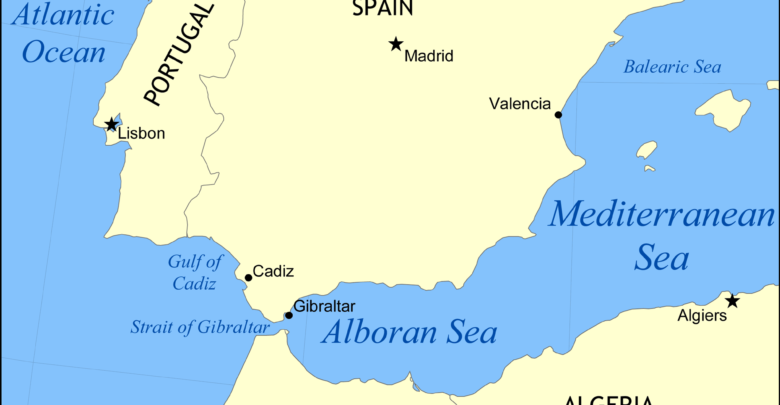Why is there Still no Bridge from Europe to Africa?

Geologists assert that the Mediterranean Sea was originally a lake with no exits in either the east or west.
However, the tectonic plate movement and other processes altered the shape of the continent: first, the sea shrank in the East, leaving the autonomous Black and Caspian Seas to stand out.
Second, some unfathomable reason caused a strait to form between Europe and Africa.
By the way, it is just 13 kilometers long, and with good visibility, residents on the Moroccan and Spanish sides can see the other shore.
In total, almost 90 million people live in the region, and the idea to connect both states and continents with a steel or at least a concrete bridge strip is in the air.
But for some reason, no one is in a hurry to implement it physically.
The region is home to about 90 million people in all, and there is talk of building a steel or at the very least a concrete bridge strip to link the continents and the states.
But for some reason, nobody seems eager to put it into practice practically.
Also Read: Blue Town Chefchaouen in Morocco’ The Blue City Seen From The Sky
Why is there Still no Bridge from Europe to Africa? Let’s investigate
The concept of building a bridge with a length of 13 kilometers is easy and does not appear to be utterly impossibly to current engineers.
For instance, the bridge that was recently opened between the Kuban and the Crimean Peninsula practically approaches 20 kilometers.
Additionally, there are bridges in China that are 40–50 kemes (or even longer) in length.
The longest bridge over water now in use is between Hong Kong and Macau, former colonies of Portugal and Great Britain, respectively, which were restored to Beijing a little over two decades ago.
We do not count overpasses over desert or marshy areas, of which there are also numerous in China. It is 56 kilometers long.
So why doesn’t Europe have a bridge? Or do the engineers actually have less money? No and yes.
In the middle of the nineteenth century, people began to fantasize of connecting the beaches of Africa and Europe.
For this, it was once even suggested to construct a dam and completely close the Strait of Gibraltar. Fortunately, this quest lacked any necessary supplies.
However, the bridge project was in the works, and in 1979 the governments of Morocco and the newly restored Spanish Bourbons agreed that the concept was a sound one.
The Moroccan king even hoped that the bridge would be finished in his lifetime in 1988. These expectations, however, were in vain.
The issue is that such a design cannot be made at the current level of technical advancement in Europe, which includes the standards for safety and dependability.
Constructing a service architecture as a team
The strait is excessively deep, which presents the biggest challenge.
In an area where there are few rocks in the way, the seabed descends to a depth of one kilometer (keep in mind that the strait in Kerch is no deeper than 30–40 meters, and the Eiffel Tower is less than four times that).
Naturally, you may make a short detour to the west, where the ground begins to rise.
However, even in this scenario, when the strait’s width has been enlarged to 25 kilometers, you will still need to install supports that are 300 meters deep.
The multidirectional currents present even another challenge, making it extremely difficult for engineers and hydraulic specialists to determine the resistance of the structure.
But even at 300 meters high and under water, the supports remain an impossible challenge if you can manage this.
The longest extant supports are columns with a height of 122 meters on thirty-meter piles for the Padma Bridge that is now being built in the Republic of Bangladesh.
The bridge’s structural complexity is regarded as being extremely high, and the project’s ambitions border on impossibility.
What therefore can be said about the likelihood and practicality of constructing a bridge over an ocean with supports that are close to a kilometer, or even, god forbid, 300 meters long?
That is not feasible. Not this decade, and probably not this century either.
Also Read: Sub-Saharan Africa: History, Geography, Politics and Racist Undertone
The European Tunnel
You can construct a road underneath water where it is difficult to build a bridge over it.
The European Tunnel, which connects France and Great Britain and passes over the English Channel, is the most well-known tunnel with comparable features. It is longer than 51 kilometers.
Perhaps that is the answer?
Unfortunately, tunnels are more expensive and less dependable. Construction at the current stage of technological development is also unfeasible because to the Azores-Gibraltar fault, which runs along the ocean floor here between Africa and Europe. Or perhaps how? You can construct it. How about if the plates shift?
Okay, tunnel, but tens of miles’ worth of coastal infrastructure will also be destroyed. This argument may be illustrated by the occurrence in 1755, when an earthquake along the shore entirely destroyed Lisbon, the capital of Portugal.
The challenges of working with a very hard rock are another factor. The design of the tunnel had already been ordered to engineers in Spain, but they were compelled to cancel the order because the base of the seabed was too hard and difficult to work with.
The fact that construction was refused in the 1930s does not, however, imply that it was not done in principle later. They even created a trace after determining the optimal path for the tunnel to be built.
How Long Will It Take
Therefore, if the project is completed, the tunnel will have a total length of 39 kilometers, of which 28.5 kilometers would be under water.
The tunnel will have a three-degree slope and a maximum laying depth that is just shy of 500 meters.
Optimists predict that it will take 10 years, fifteen million euros, and thousands of people to complete the project.
The project has possible investors, which is remarkable! The British were forced to deal with food shortages and rising costs for its supplies after exiting the EU and abandoning the responsibility of helping people in Eastern Europe.
Therefore, they will benefit from the building of a bridge in Morocco, where they cultivate all the essentials for the British, like tomatoes, oranges, and berries.
Accordingly, the Gibraltar Peninsula, which is under British control, will benefit from the increasing economic activity of regional players, while the Spanish and Portuguese would see a little decline.





